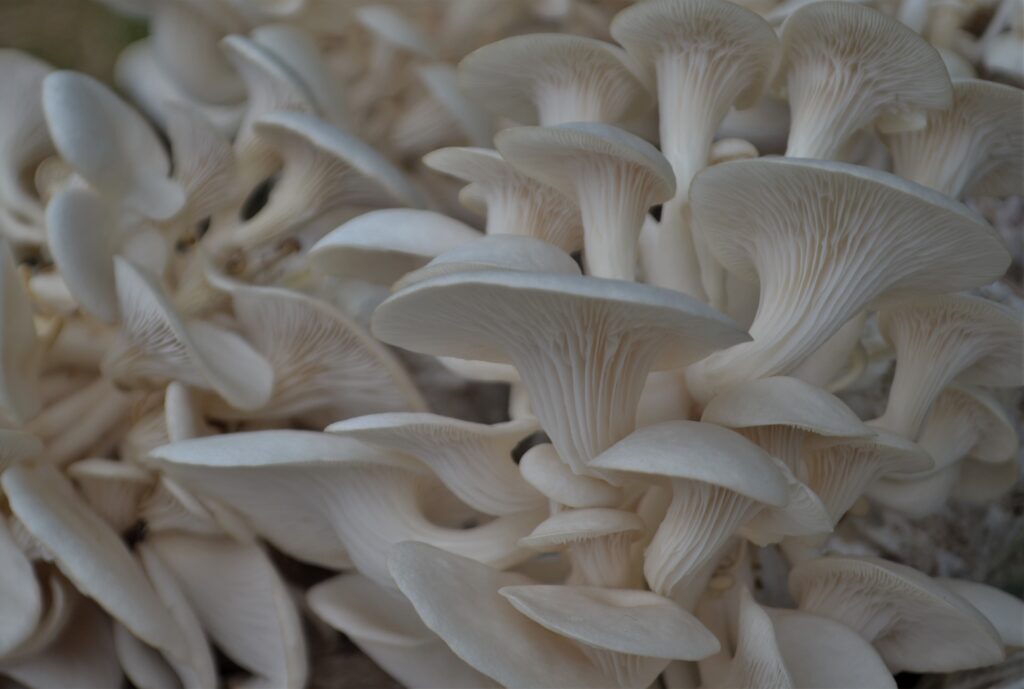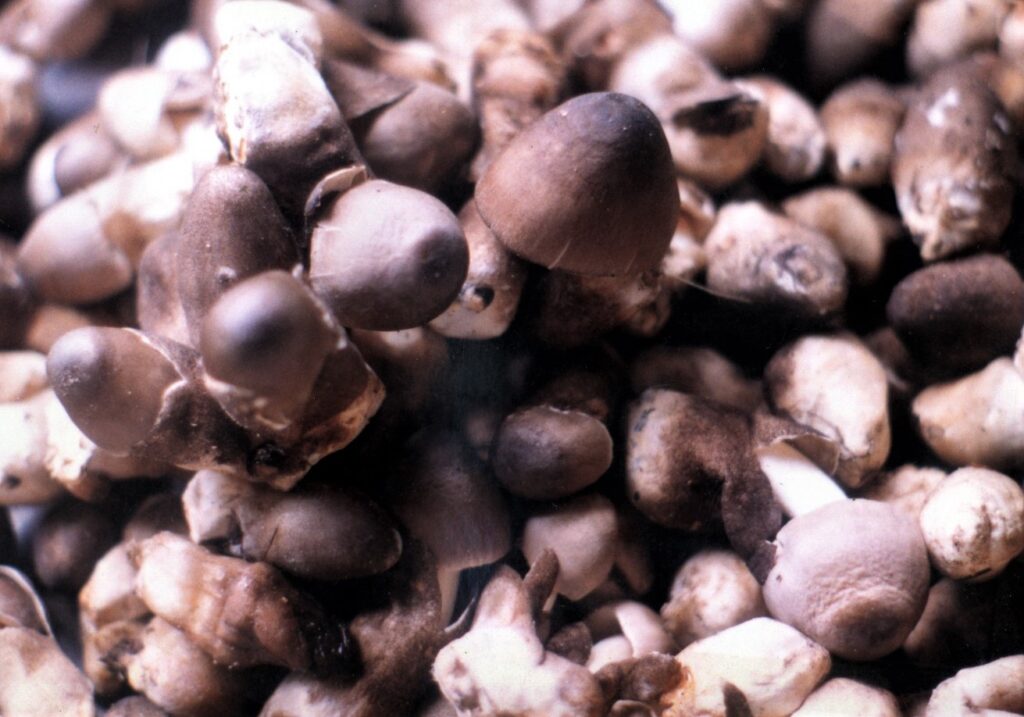Text and Photos by Henrylito D. Tacio
Mushroom is among the most nutritious and popular foods. The ancient civilizations of Egypt, Rome, and China knew of the importance of edible mushrooms as food. Egyptian pharaohs zealously kept the mushrooms for their own use, decreeing it was too delicate a morsel for commoners – who could eat garlic!
The Romans restricted mushroom consumption to the nobility. Later, convinced that mushrooms gave their soldiers strength, the Romans permitted them to eat the fungus. The ancient Chinese called mushrooms the “divine fruit of immortality,” and Buddha is believed to have eaten them before being transported to nirvana.
More than 100,000 varieties of mushrooms have been discovered, of which 2,000 are reportedly edible or fit for human consumption. The most widely cultivated mushroom species are “kabuting saging,” “tainga ng daga,” shiitake, abalone, and champignon.
Actually, the mushroom is not a vegetable, although people consider it as such. “All mushrooms are fungi and they produce spores, similar to pollen or seeds, which allows them to spread or travel by the wind,” wrote Nicola Shubrook for the good food website of British Broadcasting Corporation. “The rest of the mushroom then matures, typically living in soil or wood.”
Nutrient density is the term used to describe the concentration of nutrients per calorie offered by a given food. In his book Eat for Health, Dr. Joel Fuhrman ranks a variety of foods based on their nutrient density, and mushrooms score 134, which is higher than most fruits, including blueberries and raspberries, some vegetables, and all meat, eggs, and dairy products. In fact, Fuhrman includes mushrooms among the foods so nutrient-dense and low-calorie that they can be eaten in unlimited quantities.
Megan Ware, writing for Medical News Today, says mushrooms contain protein, minerals, and antioxidants (chemicals that help the body eliminate free radicals). Of the latter, the agents found in mushrooms are selenium, vitamin C, and choline.
Mushrooms are also rich in B vitamins, such as riboflavin (B2), folate (B9), thiamine (B1), pantothenic acid (B5), and niacin (B3). “B vitamins help the body get energy from food and form red blood cells,” Ware wrote. “A number of B vitamins also appear to be important for a healthy brain.”

Luscious mushroom 
Mushroom for sale
One of the best things about mushrooms is that they are very low in calories. One cup of button mushrooms, for instance, has just 15 calories. Mushroom’s low-calorie count is just one reason it is an important fat-burning food.
Mushrooms are also a fat-free food, which is helpful when you need to lose weight. What’s more, mushrooms have no cholesterol and less than 1% of your daily value of sodium. Although not a lot, mushrooms also contain small amounts of protein, carbohydrates, and fiber, which aid in fat loss.
The Chinese recognized the medicinal properties of some mushrooms and featured them in their herbal medicine tradition, according to E.R. Boa, author of the book Wild Edible Fungi: A Global Overview of Their Use and Importance to People.
Mushrooms contain some of the most potent natural medicines on the planet. Of the 140,000 species of mushroom-forming fungi, science is familiar with only 10 percent, according to world-renown mycologist Paul Stamets, who has written six books on the topic.
Mushrooms can be an ideal low energy diet for diabetics as they have no fats, no cholesterol, very low carbohydrates, high proteins, vitamins and minerals, a lot of water and fiber. More importantly, they contain natural insulin and enzymes, which help break down sugar or starch in the food.
Mushrooms are also known to contain certain compounds which help the proper functioning of the liver, pancreas, and the other endocrinal glands, thereby promoting the formation of insulin and its proper flow. Diabetics often suffer from infections, particularly in their limbs, which tend to continue for long. The natural antibiotics in mushrooms can help protect diabetics from this dreaded situation, too.
Research conducted in Japan identified a specific amino acid in shiitake that helps speed up the processing of cholesterol in the liver. In a 1974 study, 40 elderly individuals and 420 young women consumed nine grams of dried shiitake or the equivalent amount of fresh shiitake (90 grams) every day for seven days. After a week, total cholesterol levels had dropped seven to 15% in the older group and 6 to 12% in the young women.
Mushrooms, as stated earlier, are rich in B vitamins, which are vital for turning food (carbohydrates) into fuel (glucose) that the body burns to produce energy. They also help the body metabolize fats and protein. “Mushrooms contain loads of vitamin B2 and vitamin B3,” reports Margaret Nearing in an article that appeared in Best Health Magazine.
An analysis of seven studies – published in Cancer Epidemiology, Biomarkers, and Prevention – showed that the higher the level of selenium, as measured in blood serum and toenails, the lower the risk of bladder cancer. Selenium had a significant protective effect mainly among women, which the researchers believe may result from gender-specific differences in its accumulation and excretion.
The website of Organic Facts also cites the following health benefits of mushrooms:
Cholesterol levels: Mushrooms themselves provide a person with lean proteins since they have no cholesterol or fat and are very low carbohydrates. The fiber and certain enzymes in mushrooms also help lower cholesterol levels. Moreover, the high lean protein content in mushrooms helps burn cholesterol when they are digested.
Blood pressure: Studies of various types of mushrooms have shown them to be high in potassium content. Potassium acts as a vasodilator, relaxing tension in blood vessels and therefore reducing blood pressure. High blood pressure is connected to a number of deadly conditions, particularly heart attacks and strokes. Potassium also increases cognitive function because increased blood and oxygen flow to the brain stimulates neural activity. Studies have shown that increased levels of potassium improve memory and knowledge retention.
Anemia: Anemic patients are characterized by having low levels of iron in their blood, resulting in fatigue, headaches, reduced neural function, and digestive issues. Mushrooms are a good source of iron, and over 90% of the nutritive iron value can be absorbed by the body, which promotes the formation of red blood cells and keeps people healthy and functioning at their full potential.
Unfortunately, not all mushrooms are created equal, says Dr. Andrew Weil, founder, and director of the Arizona Center for Integrative Medicine at the University of Arizona Health Sciences Center. He mentions four varieties which are good, health-wise:
Shiitake: Also known as the oak, Chinese, or black forest mushroom, these mushrooms have broad, umbrella-shaped caps and wide-open veils. Animal studies have shown that these flavorful and readily available mushrooms have anti-tumor, cholesterol-lowering, and antiviral properties.
Enoki: Characterized by their fragile, flower-like with long, slender stems and tiny caps, they appear to have significant anti-cancer and immune-enhancing effects, according to Dr. Weil.
Maitake: Also known as ‘hen of the woods,’ these mushrooms are characterized by a cluster of dark fronds with a firm and supple texture at the base that becomes brittle and crumbly at the edges. This variety may have anti-cancer, antiviral, and immune-enhancing properties. It may also reduce blood pressure and blood sugar, says Dr. Weil.
Oyster: They are characterized by their fluted and graceful appearance; color ranges from soft brown to gray. Less expensive — and less flavorful — than shiitakes, these mushrooms may also provide some protection against cancer, Dr. Weil says.
Not all mushrooms are edible; there are those which are highly poisonous and look strikingly similar to their edible counterparts. An unknown author once wrote: “Love is like a poisonous mushroom — you don’t know if it is the real thing until it is too late.”
Claudius II and Pope Clement VII were both killed by enemies who poisoned them with deadly mushrooms. Buddha died, according to legend, from a mushroom that grew underground. Buddha was given the mushroom by a peasant who believed it to be a delicacy.
The World’s Healthiest Foods cautions: “Don’t ever try picking up mushrooms from woods unless you identify them very well. Do not trust the unknown vendors, too. Always trust sealed products from reputed companies or those which you grow yourself under controlled conditions after buying their seeds (called spawns) from trusted sources. Avoid eating discolored mushrooms or those which are different in color than the characteristic color of their species.”

